

 |
IRDS
OF FEATHER
|
 |
 |
Feathers
are the most distinctive characteristic of birds. Their main purpose is
to lift the bird into the air. Another important function is to protect
the animal from the wet or cold. Feathers are also important in the attraction
of possible mates.
|
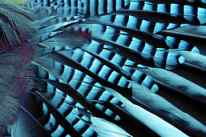 |
|
Wing
Feathers of a Jay
|
Wing
Feathers of a Jay
|
 |
Feathers are completely made up of the protein keratin. They are built to be as light as possible in order to make the bird fly easily, yet are extremely strong and waterproof at the same time. The quill in the center of the feather provides a backbone around which the feather is constructed. Extending from both sides of the quill is a linear cluster of barbs. This is where the majority of the feather's pigments are located. A network of fine barbs with interlocking hooklets lends both stiffness and flexibility to the feather. The barbs also fasten the single feathers to one another. There are about 300 million tiny barbs in one feather alone. Once the barbs come apart the feather looks ruffled. |
 |
|
Mallard
Duck Feather, Microscopic Picture provided by Molecular Expressions
|
|
Turkey
Barbule Hooklets, Microscopic Picture provided by Molecular Expressions
|
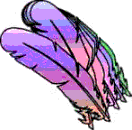 |
Feathers are water repellent due to the secrete oils which are produced by the bird´s preen glands. The animals are constantly applying the oil to their plumage. The beauty of a feather is largely based on the quality of its colors.
|
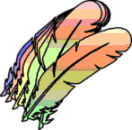 |
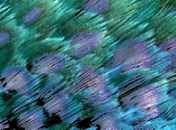 |
Most colors in feathers are determined by their pigments. Other colors like some greens or violets are based on the reflection of light - the prism effect. The colors that are not absorbed are reflected back towards the observer, thus the feather appears to be colored. A jay bird does not actually have blue feathers at all. The shimmering trick of iridescent coloring is an effect which occurs when light enters a feather and interacts with the cell membranes of some colored regions. The hummingbird´s colorful throat is a well known example of such coloring. |
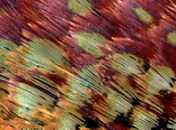 |
|
Close
up of Feathers
|
Close
up of Feathers
|
 |
The bird´s fluffy pyjamas have been categorized into groups according to their position on the bird´s body. Contour feathers are found on the wings and backs. Down feathers are usually placed underneath the contour feathers to provide insulation for the animal. Flight feathers cover the wings and the tail. Tail feathers are relatively large and function as rudders. Feathers growing on wings expand the surface during flight to increase the lifting force. To the left you can see what birds would look like if stripped off their feathers. Even when fully clothed, the rulers of the sky do not have an extra ounce of weight anywhere on their body - very unlike us humans. Their weightless plumage is in accordance with this concept of lightness. |
|
Bird
Bones, discovered in the "Puu Naio Cave" in Maui, Hawaii
|
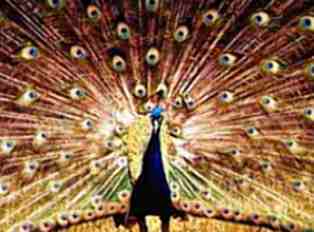 |
A great way to learn more about the numerous different kinds of feathers is to visit one of the feather quest sites the internet offers. You are presented with a feather and are kindly asked to identify the bird it belongs to or have to answer questions like the following: "Where on the body is the feather from? Which side of the feather is up? What kind of nest does this bird use?" Please go to the link section to find addresses of Feather Quest sites. |
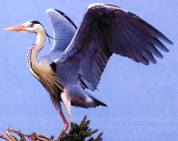 |
|
Peacock
|
Gray
Heron
|

|
|
This
feather fossil has been found in Wyoming and is about 50 Million years
old - Picture provided by StoneJungle
|
|
The
evolution is said to have changed the scales of reptilians into the decorative
plumage of birds. Feather fossils and and fossil feathered bodies have
been found all around the world as magical snapshots of history. Fossils
are a great source of information for Ornithologists to learn more about
former bird species and their structure of feathers.
|
 |
|
Birds
with Feathers Fossils found in Wyoming - Picture Provided by StoneJungle
|
|
Special
attention is paid to feathers by bird breeders. The color, form and strength
as well as other feather characteristics determine the quality of the
bird.
|
 |
| Fossil Birds from StoneJungle | http://www.stonejungle.com/fossil-birds.htm |
| Molecular Expressions Feather Photos | http://micro.magnet.fsu.edu/micro/gallery/feathers/feather.html |
| On-Line Encyclopedia | http://www.encyclopedia.com/articles/04399.html |
| Color in Bird Feathers | http://www.ednet.ns.ca/educ/museum/mnh/nature/winbirds/structur.htm |
| Native Tech´s Feather Quest | http://www.nativetech.org/feather/feather.html |
| Birdnet´s Feather Quest | http://www.nmnh.si.edu/BIRDNET/FeatherQuest/FeatherQuest.html |
| The Bald Eagle´s Flight | http://www.kwic.com/~pagodavista/body.htm |
| Bird Source Online | http://birdsource.cornell.edu/ |
| Pet Expo - Bird Items | http://www.petexpo.net/birda1.htm |
| Bird Related Links | http://geocities.datacellar.net/Heartland/4958/birdlinks.html |
| Feathers in Bird Breeding | http://www.budgerigars.co.uk/genetics/kellatt.html |
| The Birds of Japan | http://www.nikon.co.jp/main/eng/society/birds99_00/199906/index.htm |
|
Touch
the feather to get back to the top
|
|
|
|
Close
Ups of Feathers bought from Corbis
|
|
Jay
Wing Feathers purchased at Corbis
|
|
Bones
Picture bought from Corbis
|
|
Eagle
Image - Corel Draw Clipart
|